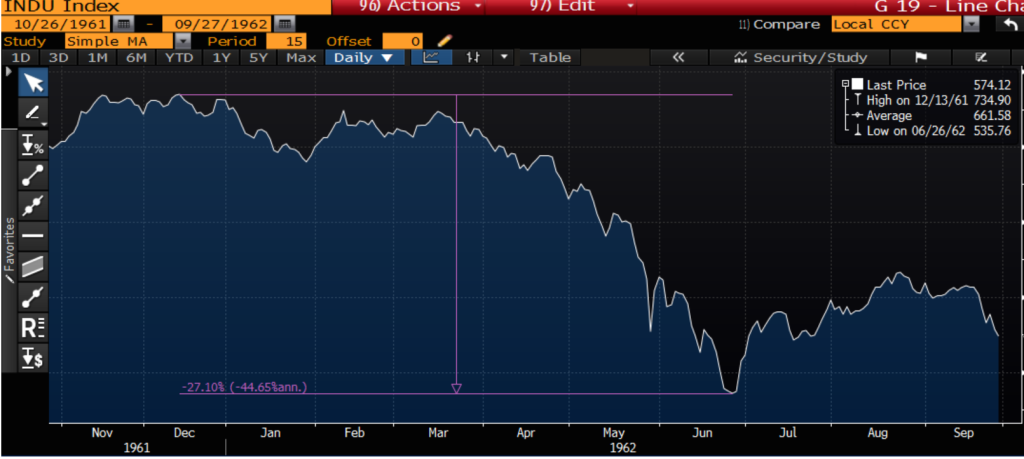Source: Bloomberg
On this day 53 years ago, Wall Street had one of its worst sessions ever. As the Wall Street Journal reported, “The Dow Jones Industrial Average fell 5.7%, down 34.95, the second-largest point decline then on record.” It was part of a longer decline that some called the “Kennedy Slide of 1962.”
Even though stocks had climbed for more than 15 years in the postwar rally, many investors were nervous that year. As LIFE magazine reported, the psychology underlying the 1962 retreat was still fixated on the crash of 1929:
The glacial heights of the stock boom suddenly began to melt in a thaw of sell-off. More and more stocks went up for sale, with fewer and fewer takers at the asking price. Then suddenly, around lunchtime on Monday, May 28, the sell-off swelled to an avalanche. In one frenzied day in brokerage houses and stock exchanges across the U.S., stock values — glamor and blue-chip alike — took their sharpest drop since 1929. Memory of the great crash, and the depression that followed, has haunted America’s subconscious. Now, after all these years, was that nightmare to happen again?
It seems odd to blame the recency effect for a preoccupation with events 33 years earlier, but that’s what it was. The enormous impact of 1929 and the Great Depression had outsize and lasting effects that haunted investors decades later. It was still lurking even after the highs of 1929 were surpassed in 1954. Post traumatic crash disorder is the tendency to obsess over what happened in the past, and project it forward as the most likely future outcome.
Warren Buffett’s quote, “In the business world, the rear view mirror is always clearer than the windshield,” is even more applicable to investing. The adage that every general fights the last war comes to mind.
Not all market crashes are created equal, of course, nor are the reactions to them identical. In the mid-1990s, there seemed to be a very practical perspective to the stock market’s gains. Several years later, when the tech and dot-com bubble collapsed, there was almost a collective shrug of relief. Don’t get me wrong, trillions of dollars were lost, and lots of speculators were devastated. But the Nasdaq 100 Stock Index had returned 85 percent in 1998, and 102 percent in 1999, and was sporting a price-earnings ratio of more than 100. It didn’t come as a terrible surprise when things blew up. No one knew exactly when that crash was going to arrive, but it didn’t seem to be all that much of a surprise when it finally came.
Contrast that with the year before the 2008-09 crash: you could hardly find anyone who was willing to talk about derivatives, subprime mortgages or the imploding real-estate market. That was a surprise. Even though there seem to be lots of people now claiming that they saw it coming, in reality only a tiny cohort were specifically negative in late 2007.
I was reminded of this by Peter Boockvar, chief market analyst of the Lindsey Group, at a dinner last night. He was one of a dozenattendees, all of whom took turns waxing eloquent about the state of the economy, the stock market and the Federal Reserve. Boockvar mentioned the memory of when he and I had marveled after a television appearance about how rampantly bullish investors were at the time. There were very few bears in 2007. But today, you can find all manner of ursine company, from gold bugs and end-of-worlders to Fed haters and Hindenburg Omen devotees.
Hence, the psychological parallels I see now are to 1962, and the collective memory of the crash of 1929, rather than 2007 and the legacy of the dot-com bubble burst. There is a deep reluctance today to believe that the recession is over; to recognize that inflation is nowhere in sight; to admit that the market rally is more than just the result of Fed actions; to ignore positive economic data; and to disregard the huge recovery in corporate profits.
As Jason Zweig noted, the crash of 1962 is a reminder that “markets always have been messy and that investors’ morale always has been fragile.” And so it is today.
~~~
Originally published at: Market Crashes Haunt Investors for Decades



Interesting column. With respect, I’ve wondered if you’ve suffered a bit from a recency bias in that your entire trading life has largely been within a secular bull market. I think it makes a lot of sense that if underlying cycles are very long, then recency biases would have similar durations.So it sounds like you believe the market valuation is justified currently based on fundamentals?Have you looked at how much of the net inflows to equities have been from corporate buy backs in the last several years (which I know you generally dislike)?
~~~
ADMIN: Our host started his career post Netscape IPO, was trained in the run up to the 2000 crash. Do the math, and the majority of his time spent as a professional in finance has been during a secular Bear Market (2000-2013).
Isn’t that why Technical Analysis (TA) works (to the extent that it works)? All of human foibles captured by the recurring patterns induced by fear and greed.